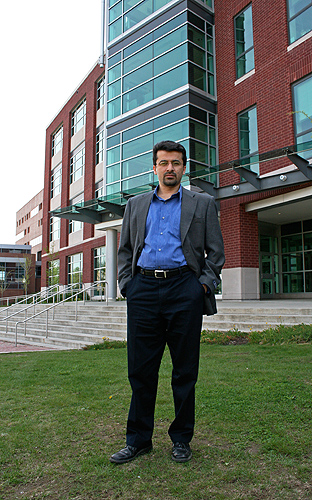
A national consortium of hardware security specialists led by experts from the University of Connecticut has received a $1.2 million federal grant to conduct wide-ranging research aimed at enhancing the integrity of integrated circuits, the computer chips that are used in virtually all electronic devices today.
The consortium, made up of experts from UConn, the Polytechnic Institute of New York University, Rice University, and the University of California, Los Angeles, has developed a web-based exchange network dubbed Trust-Hub, that serves as a resource for research, education, and collaboration among hardware security experts.
The Trust-Hub consortium aims to establish criteria for determining the “trustworthiness” of integrated circuits, and to develop trust benchmarks for the hardware security community, along with common hardware platforms for the validation of solutions. A central feature of the project is the web-based Trust-Hub repository, which will help ensure widespread access to the latest tools and knowledge in hardware security and trust.
The Trust-Hub website also serves as a clearing house, where researchers can exchange papers, and provides information about activities such as technical events, workshops, seminars, and news stories in addition to online courses and tutorials.
“Malicious computer hardware is a difficult and growing problem, and one that poses new research challenges,” says Samuel Weber, trustworthy computing program officer at the National Science Foundation, which funded the Trust-Hub project. “This project promises to build and support a community of researchers to tackle this challenge by providing much needed infrastructure.”
The grant’s principal investigator is Mohammad Tehranipoor, associate professor of electrical and computer engineering at UConn. Co-principal investigators include Farinaz Koushanfar, assistant professor of electrical and computer engineering at Rice University; Ramesh Karri, professor of electrical and computer engineering at the Polytechnic Institute of New York University; and Miodrag Potkonjak, professor of computer science at UCLA.
“The objective of the Trust-Hub project is to lead a community-wide movement toward stronger assurances in the hardware industry,” says UConn’s Tehranipoor. “The Trust-Hub is a means for information-sharing between researchers and practitioners to accelerate the development of defenses against hardware-level attacks.”
Koushanfar, of Rice University, says, “We believe the Trust-Hub can provide opportunities to synchronize research activities in this community and help accelerate research and development by providing baselines for examining various methods developed by researchers in academia and industry. This will help establish a sound basis for the ‘hardness’ of each design instance, and it will result in common platforms that can enable effective implementation of methodologies. We will make all benchmark circuits, tools, and common platforms available to the public.”
Another important capability available on the Trust-Hub website is simulation tools that can be accessed from a local web browser, enabling researchers to explore and simulate a specific science area.
The researchers will develop benchmark circuits – “trust benchmarks” – infected with hardware Trojans with the aim of creating hardware platforms to validate trust.
Karri, of the NYU Polytechnic Institute, says that in the last decade, researchers have made important advancements in hardware security and trust. However, the effectiveness of these methods is not universally accepted, and some are applicable only to specific designs, platforms, and technologies. The lack of universal solutions for integrated circuit security is an underlying premise for the Trust-Hub collaboration.
“This project will greatly impact the research and development in the security community and has the potential of coordinating research among various institutions and government agencies,” says UCLA’s Potkonjak. “In addition, it helps facilitate technology transfer to industry, since the methodology and implementation becomes repeatable in practice.”


